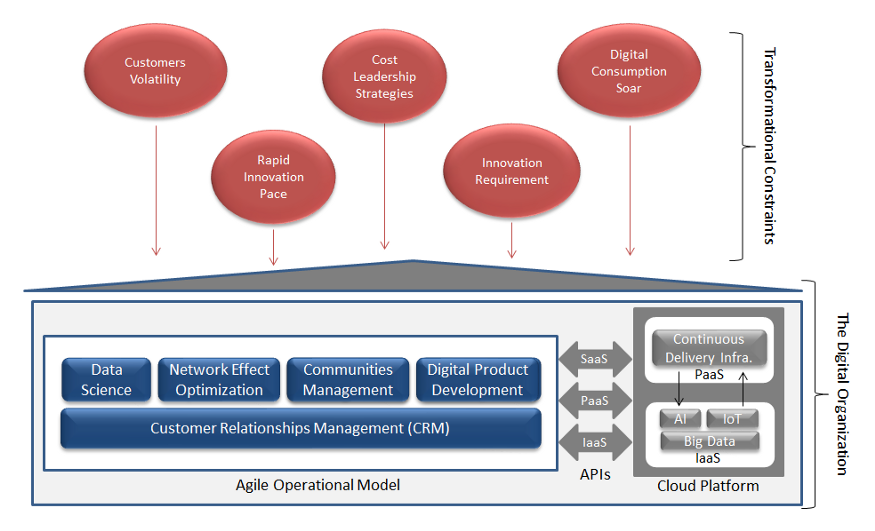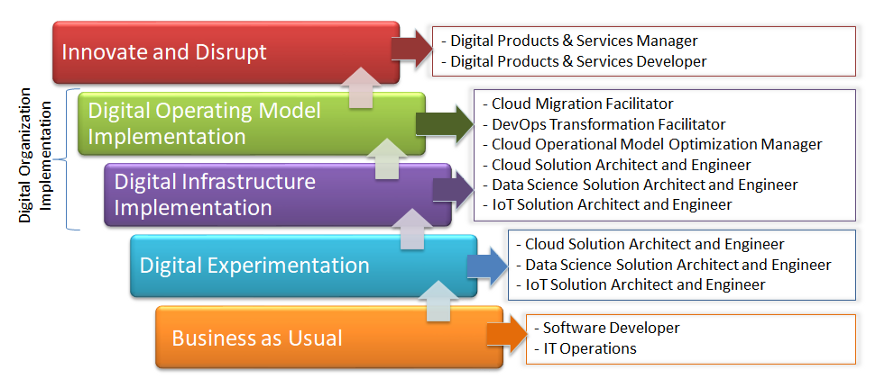The digital business expansion in the global economy introduces changes that certain IT professionals aren’t prepared for; what I see is frustrated tech workers, paralyzed by the fear that they have to make that digital technology career change.
What’s happening is, the massive marketing surrounding the recent IT innovations — cloud computing, DevOps, big data, containers, microservices, artificial intelligence, blockchain — makes the new IT landscape blurry; it prevents these staff from properly assessing the impacts on their job and career, and more importantly, from taking the right actions.
Worried tech workers can be reassured, making the digital shift isn’t insurmountable. It’s no different from the previous IT revolutions, the effects of the digital technologies are the same, they make the company’s processes effective and efficient, they increase staff productivity, and compel them to adapt to their philosophy, principles, and practices.
What does make digital career changes supposedly complex? What do you need to make it successful? What challenges and opportunities are on the table? In this article I provide unique answers and tools that’ll not only give you precious information about the ongoing industry digital transformations but also guide your digital career change.
Be careful! IT vendors’ reckless marketing gives a misleading picture of the digital technology job needs
Tech companies competition to control market shares and accelerate revenue forces them to overexaggerate digital technology benefits. Their bottom line is to sell, not necessarily to help. That’s making IT marketing a problem.
Let me say it straight, slogans such as, “Cloud is mature, ninety percent of businesses which invested in it have increased their revenue by forty percent,” “Businesses which invested in DevOps have seen their competitiveness grow by seventy percent” or “Digital transformation is only about implementing the recent information technology innovations” do not reflect the reality, they’re false.
As to cloud, insightful surveys show that, “Ninety percent of cloud investments are focused on infrastructure and their primary goal is to reduce IT expenses and speed up IT operations hoping it boosts the business.” The question is, how is it possible that, in today’s digital business context where rapid and continuous innovation is the key competitive advantage to have, there are still some to believe that implementing cloud infrastructure is enough to gain market shares, accelerate revenue growth, and increase brand equity?
Same thing for DevOps, a close look at how ninety percent of businesses have been implementing it shows that, “Deploying Continuous Deployment (CD) infrastructure is stressed as if, on its own, it’s enough to help with the many competitive challenges out there.” Again, how is it possible that, there are still some to believe that automated software deployment on its own is enough to help businesses compete with Google, Amazon, Facebook, Apple, Walmart and the other Asian tech giants?
DevOps is a typical example of how extravagant marketing is toxic; from being “primarily a new organizational and cultural way of organizing development and IT operations work,” it’s now, on purpose, presented as “the extensive utilization of Continuous Deployment (CD) infrastructure in an effort to accelerate software delivery.”
The messages sent about Cloud and DevOps aren’t only exaggerated, they also give the feeling that technology implementation jobs are the only ones needed. They’re not! Today’s Cloud and DevOps solution architects and engineers are primarily tool — AWS, Azure, Google, OpenStack — specialists, not the expected digital transformation experts. Period.
The key takeaway at this point is, content marketing is essential source of information for digital career changes. However, always have in mind that, because their primary goal is to promote a specific vision, business, technology, service or product, chances are the infographics, videos, articles, white papers you like so much provide incomplete information.
Understanding digital disruption is the first step towards not only successful business but also rewarding and long-term digital technology careers.
If you want to enjoy safe, exciting and high-paying jobs, have industry-leading firms in your record, and enjoy rewarding and long-term digital career, you don’t have the choice but to understand what’s known as Digital Disruption. The fact that IT marketing has made it a buzzword shouldn’t make one lose sight that it’s the key to understand the changes happening in most industries and their impacts on jobs and careers.
In a nutshell, digital disruption is the process whereby tech companies utilize their platform business model and the innovative digital products and services they create to offer greater value to the customer in a way that established incumbents are forced to adapt or die.
 The Digital Organization Model — Credit: Designed and Developed by Philippe Abdoulaye
The Digital Organization Model — Credit: Designed and Developed by Philippe Abdoulaye
“Platform?” you might be asking! Knowing what this central concept of the digital business means, how it works and impacts your industry will not only help you understand your future but will also equip you with a feature that makes up top digital technology experts: understanding of the digital disruption’s implications on the business.
Simply put, a platform is a business model supported by marketplace technologies. It creates value involving into a community three players: the Platform Owner which facilitates business transactions between Providers who deliver the services and Consumers who buy them.
The notion of Community and its correlated Network Effect help to understand how tech companies have been disrupting industries to make money. The network effect is the notion that the more a service is used, the more its value increases to its users.
As the picture suggests, to survive the transformational constraints put on companies by Google, Apple, Facebook, and Amazon (GAFA) and succeed, businesses don’t have the choice but to transform into the Digital Organization Model, it crystallizes the changes to engage in. These constraints include:
- Customer volatility resulting from clients’ attraction to the affordable innovative digital products and services; it requires that businesses implement communities of consumers as well as mechanisms to keep them loyal. It’s the purpose of the Communities Management function.
- The rapid innovation pace imposed by tech companies including the GAFA compels businesses to adopt agile philosophy and principles. It’s the reason for the interest in Agile operational models.
- The cost leadership strategies adopted by the GAFA and the other tech giants forces businesses to find out mechanisms to accelerate customers acquisition and ensure revenue growth. It’s the purpose of the Data Science and Network Effect Optimization functions.
- And the soar of digital products and services consumption forces companies to admit that software is today, the hub of digital business and investing in software development excellence is a must. That’s the purpose of the Digital Product Development function.
The second key takeaway is, transforming into the Digital Organization model will remain the top priority over the next five years; it determines the IT jobs of the digital era, how they look like, and how they’ll impact your career.
Use the Digital Organization Model to understand the technology staffing requirements of the digital economy and spot your career opportunities.
The digital technology jobs are correlated to the changes brought in by the digital organization model, they’re grouped into five staffing areas:
- Data Science whose goal is to help the company understand its markets, consumers, providers, and to continuously improve practices and performance through insights and knowledge got from analyzing data.
- Network Effect Optimization whose goal is to accelerate customers acquisition and ensure revenue growth through encouraging them to consume or offering rebates and incentives for adopting, consuming, and recommending a product or a service.
- Community Management whose goal is to keep customer loyalty and engagement high and consistent through continuously tracking and improving experience.
- Digital Product Development which take advantage of DevOps and AI, IoT and big data technologies through varied cloud services to design, develop, and deploy innovative digital products and services.
- Cloud Service Management whose goal is to ensure cloud computing infrastructure and services — SaaS, PaaS, IaaS — are working optimally to deliver the expected benefits.
Each staffing area, at the operational level, is associated with two roles including Facilitator whose responsibility is to help a group of implementers to understand their common objectives and assists them to plan how to achieve these objectives and the Implementer whose chief responsibility is implementing, testing, and deploying digital products and services in accordance with the DevOps and Cloud standards.
The third key takeaway is, to effectively react to the transformational constraints put on them by their disrupting industry, survive them, and prosper, businesses must structure their digital business model into five staffing areas. In IT at the operational level, these staffing areas involve two types of role including the Facilitator and the Implementer.
Now that you’re aware that content marketing isn’t hundred percent reliable, that you understand how the five transformational constraints weigh on businesses, and how they’re turned into staffing areas and facilitator and implementer roles, you might be thinking, “How do I spot my dream digital technology job?”
Use the Digital Transformation Journey Model to spot your digital technology dream job and build a rewarding long-term career.
The Digital Transformation Journey (DTJ) is the tool that will help you spot your dream digital technology job and build a rewarding long-term career. The logic is, as the business moves across the DTJ — from bottom to top — the IT organization extends the digital maturity of its processes and practices, and new IT roles are required:

Digital Transformation Journey (DTJ) and Technology Job Opportunities — Credit: Philippe Abdoulaye
As you can see, the organization goes through four steps before reaching the supreme stage: the ability to continuously Innovate and Disrupt its industry.
At the Business as Usual stage, the weakest maturity level, the IT organization operates as if digital transformation is a fiction or isn’t a threat to its survival and growth. Software Developer and IT operations versed in either Waterfall or Agile practices and ITIL are the most demanded.
In the Digital Experimentation stage, the IT organization gets aware that digital disruption is a reality and more importantly a threat. Experimental cloud migration, DevOps transformation, and Data Science (Big Data and AI) projects are launched. Cloud solution architects, DevOps experts, and Data Science specialists with a solid IT transformation background are needed.
In the Digital Organization Implementation stages, the most challenging of all, the digital infrastructure and operational model are implemented. Project facilitators, solution architects, and engineers with a deep grasp of the business implications of digital disruption, with solid know-how in leveraging technology to enable business benefits, and well versed in emerging technology best practices are under the spotlight.
In the final stage, Innovate and Disrupt, the organization gets digitally mature; the adoption of the data science, network effect optimization, community management, and digital product development processes, practices, and tools across the organization allows the company to continuously innovate and disrupt. Digital Products and Services Manager and Digital Products and Services Developer well versed in Innovation Management and Rapid Products Development in DevOps contexts are the most demanded competencies.
The fourth takeaway is, if you want to make a fast and successful digital technology career change, the process is as simple as:
- Check where companies in your industry stand in the Digital Transformation Journey. Are they in stage 1? 2? 3? 4?
- Choose your dream job and the expected knowledge, skills, and competencies. Is it facilitator? implementer?
- Take an online training that’ll not only teach you the job and the related tools but also the process to quickly land that digital technology job.
Don’t be fooled! Many teach tools and technologies not jobs! Opt for learning a job as it also includes tools and technologies.
The proliferation of online IT courses shouldn’t let you think that all of them are good. Three common problems signaled by an increasing number of HR and hiring managers are:
- They’re focused on tools and not enough on the job specifics
- They’re too long and don’t take into account career changers’ usual emergency situation
- They’re not based on teaching strategies designed to make the learning easy and fast
The fifth and last key takeaway is, brand, reputation, price, and length don’t determine effective online IT courses. Always keep this mind when choosing a course: effective online IT courses make your learning easy and fast, they make you ready for the job.
Gain more insights on the increasingly demanded digital technology jobs: DevOps Transformation Leader and Enterprise Cloud Transformation Project Manager.
Good luck with your digital technology career!
Article by channel:
Everything you need to know about Digital Transformation
The best articles, news and events direct to your inbox







